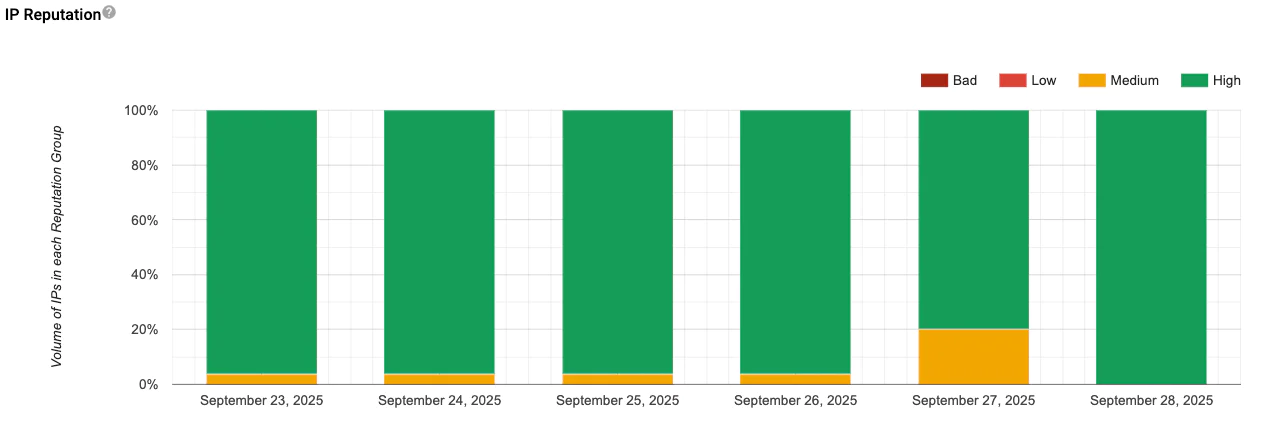Gmail to Retire Domain & IP Reputation in Postmaster Tools
Time to read:
Gmail to Retire Domain & IP Reputation in Postmaster Tools
For years, email deliverability professionals have been touting the benefits of signing up for Google Postmaster Tools, Gmail’s one-stop-shop for gaining valuable insights into sender reputation. With the announcement of Gmail’s new sender requirements came an increased focus on sender compliance over reputation, and Gmail accordingly released a v2 compliance dashboard in Google Postmaster Tools in March of 2024. While we knew the end was nigh for what Gmail themselves started calling “old Postmaster Tools,” Gmail hadn’t said much about what the depreciation of v1 would entail.
That all changed last week when Gmail announced that the old Postmaster Tools would officially retire on September 30th 2025. To the surprise of many, the official statement from Gmail shared that IP reputation and domain reputation will no longer be available in the updated Postmaster Tools. If you have relied heavily on these insights to diagnose deliverability issues for your brand or your clients, you’ll need to be prepared to shift focus once again.
Why is reputation going away, and what can we expect to replace it?
The rumor in the industry is that having IP and domain reputation shared in Google Postmaster Tools became too much of a security liability for Gmail. Perhaps the data revealed too much about Gmail’s internal scoring and created a potential vector for abuse that spammers could exploit to game the system.
It can also be said that reputation is a kind of amalgamation of other, more black and white signals like authentication health, spam complaint rates, hard bounce and block (soft bounce) rates, and engagement indicators. Gmail seems to be signaling that they want senders to shift focus back to their own email metrics in order to tighten up their sending behavior. This is a bit of a complicated ask at the moment, given how Apple MPP changed open data and how mailbox provider AI may drive down direct recipient engagement with emails even further.
That said, Gmail teased in their announcement that they will be giving senders new useful data points in v2. While they didn’t go into specifics, we know that Gmail plans to share “more useful and actionable information.” New dashboards “will launch by the end of 2025,” and there is speculation that this will include “true” engagement data that will allow senders to better understand high level recipient trends. It remains to be seen if this will be in the form of actual inbox rates, real engagement data scrubbed of Gmail image prefetching and Apple MPP opens, or something else entirely.
What exactly is being retired?
Simply put, Gmail reputation data is going away, so you’ll no longer be able to claim you know what Gmail as a mailbox provider thinks of your emails.
More specifically, you will no longer be able to see by-date “high/medium/low/bad” scores for IPs sending for a specific domain or subdomain:


You will also no longer be able to view “high/medium/low/bad” scores for your domains and subdomains:


While senders shouldn’t panic about these metrics disappearing, we also can’t ignore the fact that we’re losing valuable insights that have long helped senders identify and fix problems. Open data has become increasingly less reliable, spam complaint data is only available if at least some emails are reaching the inbox, and if Gmail outright blocks you, it’s already too late.
Those that are currently in the middle of fixing a problem will feel the disappearance of IP and domain reputation, since there will be a gap between v1 going bye-bye and v2 coming in with whatever new and exciting data points Gmail will be sharing going forward. That said, there are some tried and true practices we can lean on in the absence of this data going forward.
What now?
Spam Resource’s Al Iverson recently made what I think is the most important point to consider in all of this: “...Google wants senders to continue to be able to utilize GPT feedback to improve their sending habits, and… various GPT data that they continue to share (or plan to share in the future) will be done with this intent in mind.” Ultimately, the bottom line is that Gmail wants their users to be protected from unwanted emails. We can only hope that, in order to achieve that end, Gmail provides senders with signals that help them better understand at a high level whether or not their emails are garnering positive engagement.
For senders that rely heavily on domain and IP reputation scores from Google Postmaster Tools, this is an uncomfortable change, especially while we wait to get access to new data feeds from Gmail. In the meantime, continue to focus on the behaviors that we all know lead to positive reputation (whether that’s reflected in a score or not!):
Make sure you are familiar with and compliant with Gmail’s sender requirements. If you aren’t already using Google Postmaster Tools, get set up today! The v2 Google Postmasters dashboard tells you straight up if you meet the new requirements.
Stop sending to unengaged recipients, period. It doesn’t matter if they signed up legitimately: if there are no recent signs of interest in your emails, you need to remove that dead weight from your list because it will only cause you problems. Wondering how to identify actives and non-actives in the post-MPP world? We covered that topic here.
Monitor negative signals like spam complaints, hard bounce rates, block rates, and deferrals. Keep in mind that the threshold for spam complaints is quite low (0.1%), and Gmail will certainly take punitive action against your emails if you’re crossing over the 0.3% threshold. Leverage the Gmail feedback-id for spam complaints to get granular insights into which specific campaigns are causing complaint issues.
Use the list-unsubscribe header to make unsubscribing as easy as possible. Give people an easy out so they don’t get frustrated and hit the “report spam” button!
Leverage all the first party data you collect on your recipients to create targeted, truly personalized campaigns that your audiences want to engage with. It may sound unbelievable, but big, recognizable brands are still trying to get away with batch-and-blast sending. As mailbox providers like Gmail work to improve the inbox experience for their recipients, this lack of strategy will only multiply your email woes tenfold. That’s something we can say for sure with or without Gmail IP and domain reputation insights!
DMARC reports, not reputation dashboards, should be the primary tool you are leveraging to monitor infrastructure across your brand. Google Postmaster Tools IP reputation in particular gave folks a helpful visual to identify poor performing IPs under the umbrella of shared domains. Sometimes senders could unearth a sales-team-gone-rogue using their own IPs and causing long term damage. But you really need to know who is sending what at all times for your brand at all times, not just in one-off scenarios like this. Don’t let your DMARC reports fall into a black hole: use a DMARC reporting tool like Valimail to help monitor the full breadth of your email program.
Seedlist testing tools like Inbox Monster can help paint a picture of the overall health of your email program and authentication status.
If your brand is working on improving inbox rates or reputation at Gmail (or any other mailbox provider!), Twilio SendGrid experts are here to help. Don’t hesitate to reach out to our Professional Services team to get started with customized support and strategy recommendations for your email program.
Related Posts
Related Resources
Twilio Docs
From APIs to SDKs to sample apps
API reference documentation, SDKs, helper libraries, quickstarts, and tutorials for your language and platform.
Resource Center
The latest ebooks, industry reports, and webinars
Learn from customer engagement experts to improve your own communication.
Ahoy
Twilio's developer community hub
Best practices, code samples, and inspiration to build communications and digital engagement experiences.


